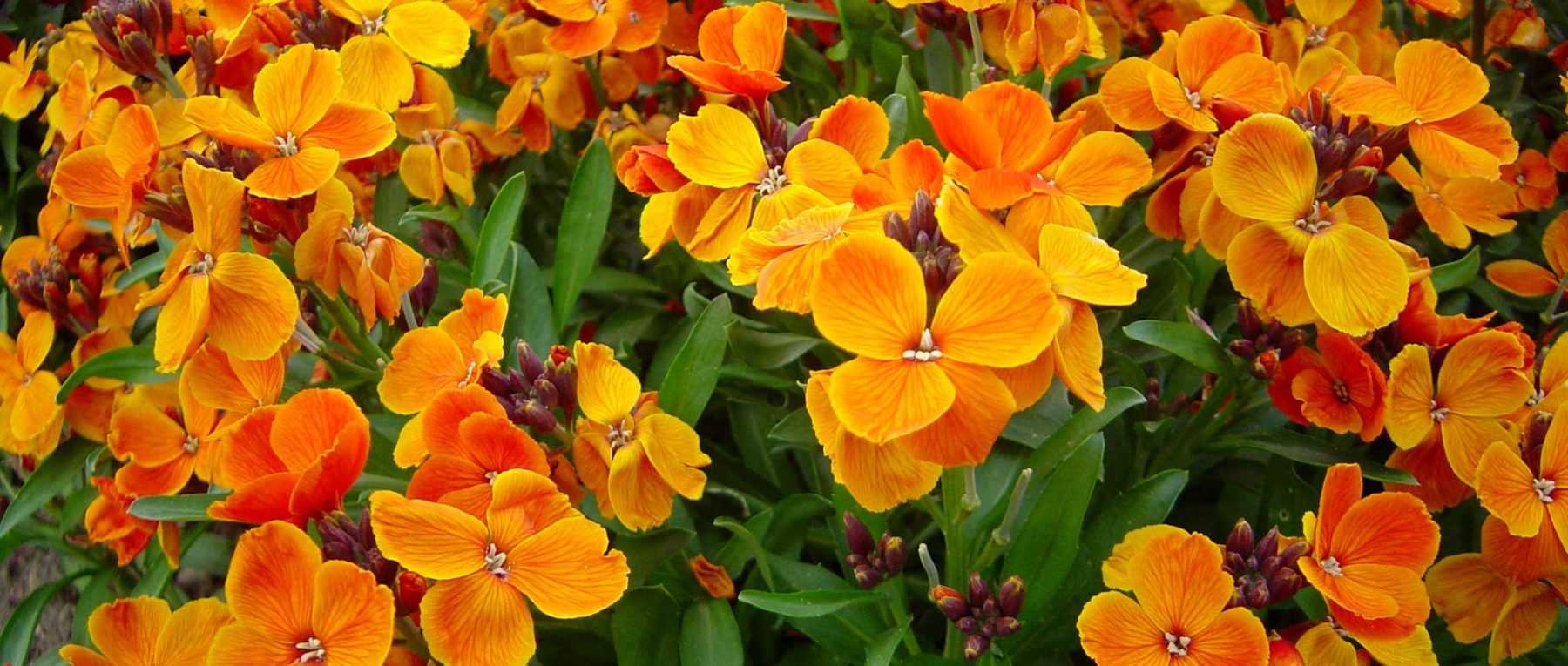
Wallflowers: sowing, planting, growing and caring
Contents
Wallflowers in a nutshell
- Wallflowers offer abundant flowering in a wide range of bright, vibrant colours
- Their flowers are divinely fragrant
- They are the perfect, easy young plant for brightening up tricky spots, tolerating poor, rocky and dry soil extremely well.
- They are easy to grow and require little maintenance
- They add colour to containers, flowerbed borders and rockeries in spring and summer
Our Expert's Word
Wallflower (Erysimum in Latin) offers a generous spring or summer flowering that comes in a beautiful palette of vibrant colours. The most well-known is the common wallflower, or Erysimum cheiri, with flowers typically yellow, orange or red. Also cultivated is the ten-week stock, or Matthiola incana, which produces large inflorescences in shades of mauve, pink, purple or white. It is sometimes called Summer Wallflower. The flowers of wallflowers are extraordinarily floriferous and fragrant plants!
This is an easy-to-grow plant that thrives in full sun and tolerates poor, rocky soils… It’s perfect for filling spots in the garden where nothing else will grow! It mainly requires well-draining soil. The common wallflower, Erysimum cheiri, is ideal for dressing old stone walls. Very undemanding and possessing good hardiness, wallflower is a rather easy plant. It requires little maintenance. It’s best to prune the common wallflower after flowering. You can propagate it by sowing or propagation by cuttings, although it sometimes self-seeds. Finally, the flowers can be used to create stunning bouquets!
Description and botany
Botanical data
- Latin name Erysimum et Matthiola sp.
- Family Brassicaceae
- Common name Wallflower
- Flowering spring or summer
- Height 20 to 80 cm
- Sun exposure full sun
- Soil type well-drained
- Hardiness often around – 15 °C
Wallflowers are perennial, biennial or annual plants with generous spring or summer flowering. The name Wallflower mainly refers to two plants: Erysimum cheiri and Matthiola incana, although wallflowers in the broad sense encompass other closely related species. The most common is the common wallflower, Erysimum cheiri, but the ten-week stock, or Matthiola incana, is also frequently cultivated. Both plants are native to Europe, particularly the Mediterranean region, but have become naturalised elsewhere.
Wallflowers can be found growing wild in France. The common wallflower is found on old stone walls, among rocks… The ten-week stock grows mainly along the coast, on cliffs, rocky outcrops or low walls.
The common wallflower is a short-lived perennial, but is often grown as a biennial.
Wallflowers were so named because their scent resembles that of cloves. They also have numerous synonyms and common names. Erysimum cheiri is known as Common Wallflower, Wallflower, Yellow Stock, or Goldstock… while Matthiola incana is often called Ten-week Stock, Summer Stock, or Garden Stock… It owes its Latin name to the Italian physician and botanist Pietro Andrea Mattioli (1501 – 1577). Erysimum cheiri is sometimes called Cheiranthus cheiri (synonyms).
The Erysimum genus includes over 200 species, while Matthiola comprises around fifty. The wallflower group is therefore very extensive, especially when you add the countless horticultural varieties obtained through hybridisation.
These plants belong to the Brassicaceae family, sometimes called Cruciferae (former name), due to their four-petalled flowers arranged in a cross. This family is known for the many vegetable and utility plants it includes: cabbages, radishes, rapeseed, mustard, rocket… It also contains ornamental plants such as Iberis, aubrietas or Alyssum…
Wallflowers are upright plants; they have erect stems bearing flowers at their tips. They are sometimes semi-shrubby, and the base of the stems tends to become woody. Wallflowers grow to between 20 and 80 cm in height. There are also many varieties selected for their compact habit (up to 40 cm tall), such as those in the ‘Bedder’ series of Erysimum cheiri, or those in the ‘Midget’ series of Matthiola incana. These dwarf wallflowers are particularly suited to container planting.
The common wallflower, Erysimum cheiri, flowers early in spring, between March and June; whereas Matthiola incana usually flowers in summer (although there are also some early-flowering varieties). Thus, wallflowers can bloom from March to September. Some varieties have the advantage of flowering as early as late winter (Erysimum ‘Winter Joy’…). It can be interesting to combine different varieties to enjoy a long flowering period!
Wallflowers offer very generous and abundant flowering. They bear inflorescences at the tips of their erect stems. Matthiola incana has large clusters of flowers, more or less elongated.
Wallflowers have flowers that are quite typical of the Brassicaceae family. They measure between 2 and 5 cm in diameter and consist of four free petals arranged in a cross. These petals are quite broad and rather rounded. They are surrounded by four sepals, and at the centre of the flower are six stamens. The flowers of Matthiola incana are sometimes double.
The flowers of the botanical species Erysimum cheiri (Common Wallflower) are orange-yellow. Generally, the varieties derived from it often take warm hues: yellow, orange, bronze, scarlet red… while the ten-week stock comes in mauve, lilac, pink, purple and white tones. Together, they cover a very wide colour palette! Wallflowers are appreciated for their bright, very luminous blooms. Some varieties offer colours that change over time! They sometimes have beautiful shades within an inflorescence, as in the Erysimum ‘Winter Orchid’.
While the flowers of Erysimum cheiri have a rather simple and natural look, and can easily fit into a cottage-style garden, those of Matthiola incana are generally more complex and sophisticated, often with double-flowered varieties and flowers grouped in large elongated clusters. They are better suited to romantic gardens, cottage gardens or English gardens… in more elaborate and sophisticated borders.
The common wallflower is a good melliferous plant. Its spring flowering attracts pollinating insects.
Wallflowers have the advantage of offering fragrant flowers, and those of Matthiola incana are ideal for bouquets.
The flowers of the Evening Stock, Matthiola longipetala, have the particularity of opening in the late afternoon. They are truly appreciated for their fragrance, which is why this plant is sometimes called “Scented Stock”.


Wallflower flowers can take on different shades. In order: Erysimum ‘Winter Party’, ‘Bowles Mauve’ and ‘Jubilee Gold’
Wallflower leaves are quite ordinary. They grow up to 20 cm long and have a slender, elongated, lanceolate shape. They are simple, usually with an entire margin, but sometimes dentate. They are arranged alternately on the stems.
Wallflower leaves are often green, sometimes slightly bluish, but can also take on beautiful grey or whitish tones (especially in Matthiola incana). There are variegated varieties, such as Erysimum linifolium ‘Variegatum’. The foliage of Matthiola incana is villous; it bears white hairs. In other species, such as Matthiola sinuata, the foliage is truly wooly.
Wallflowers have a taproot system that is relatively fragile, making repotting or transplanting delicate.
After flowering, wallflowers produce siliquas (characteristic fruits of the Brassicaceae family), containing the seeds. These siliquas are elongated and narrow, somewhat resembling small bean pods.
The main varieties of wallflowers
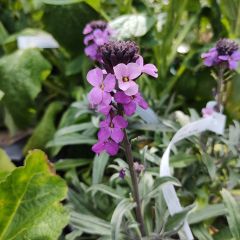
Erysimum linifolium Bowless Mauve - Wallflower
- Flowering time April to November
- Height at maturity 90 cm
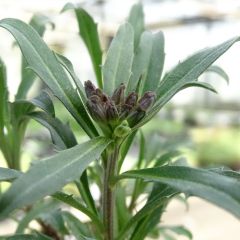
Erysimum Constant Cheer - Wallflower
- Flowering time May to July
- Height at maturity 30 cm
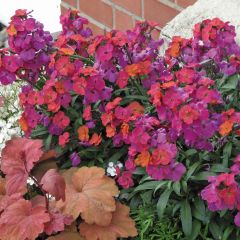
Erysimum Winter Orchid - Perennial Wallflower
- Flowering time April to July
- Height at maturity 45 cm
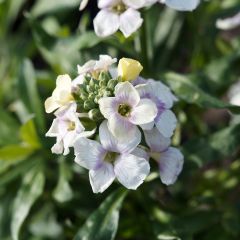
Erysimum Rysi Moon Plug Plant - Perennial Wallflower
- Flowering time April to July
- Height at maturity 30 cm
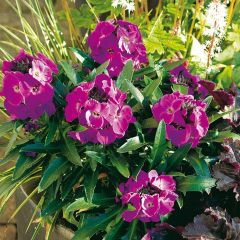
Erysimum Winter Joy Plug Plant - Perennial Wallflower
- Flowering time March to July
- Height at maturity 40 cm
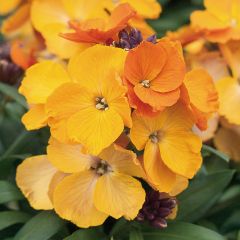
Erysimum Rysi Copper Plug Plant - Perennial Wallflower
- Flowering time April to July
- Height at maturity 35 cm
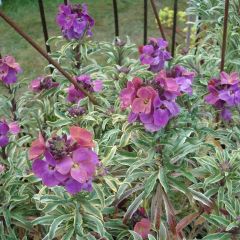
Erysimum linifolium Variegatum - Wallflower
- Flowering time June to August
- Height at maturity 50 cm
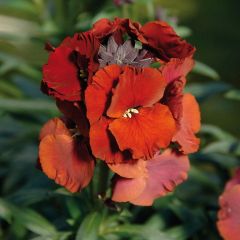
Erysimum Winter Passion - Perennial Wallflower
- Flowering time April to July
- Height at maturity 40 cm
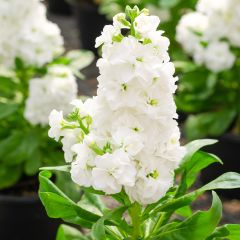
Matthiola incana Heritage White
- Flowering time June to October
- Height at maturity 25 cm
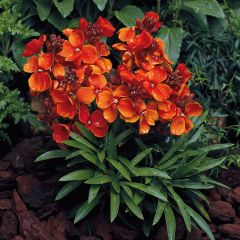
Wallflower Scarlet Bedder
- Flowering time April to June
- Height at maturity 35 cm
Discover other Wallflowers
View all →Available in 1 sizes
Available in 2 sizes
Available in 2 sizes
Available in 1 sizes
Available in 1 sizes
Available in 1 sizes
Available in 1 sizes
Available in 1 sizes
Available in 2 sizes
Available in 1 sizes
Planting and sowing wallflowers
Where to plant?
Preferably install your wallflowers in full sun! However, they tolerate partially shaded positions, but their flowering tends to be more abundant when in sunlight.
In any case, wallflowers need a well-draining medium, as excess moisture could encourage fungal diseases. They cope well with stony, rocky ground. If your soil is heavy and tends to retain water, it’s best to add gravel or coarse sand to improve drainage. You can also plant on a mound or raised bed as this will facilitate water runoff.
Wallflowers tolerate chalky soils very well. The Matthiola incana are particularly suited to coastal gardens and tolerate sea spray.
Common wallflowers, Erysimum cheiri, are perfectly content with poor, relatively dry soil, while stock wallflowers, Matthiola incana, prefer slightly richer and moister substrates. The former are undemanding plants: they can grow in very little soil, managing to thrive by simply settling in a crack between stones, for example… Matthiola incana will appreciate slightly deeper soil.
Wallflowers can find their place in a flower bed, rockery, dry or Mediterranean garden, at the foot of a stone wall… or even in a large pot or container for the most compact varieties. They are also perfect for dressing the most challenging spots in the garden. They have the ability to establish themselves where nothing else will grow!
As they emit a pleasant fragrance, it’s worth placing them near a frequently used area, along a path, or close to the house.
Because they have a fragile root system, wallflowers dislike being moved or transplanted… We advise you to carefully choose their location to avoid disturbing them later!
The taller varieties can be planted in the middle or at the back of beds, while the shorter ones can be used to edge a bed, at the front.
When to plant?
The common wallflower, Erysimum cheiri, can be planted in autumn or spring, whereas Matthiola incana is preferably planted in spring. Wallflowers can also be sown directly in situ in spring, around May.
How to plant?
Allow a planting distance of about 30 cm.
For common wallflowers, we suggest pinching the stem when planting to encourage the plant to branch out.
- Place the rootball in a basin filled with water.
- Start by preparing the ground. Loosen the soil and remove weeds.
- Dig a planting hole. Add some coarse sand or gravel if needed to improve drainage, as wallflowers dislike water-retentive soils.
- Place the rootball in the planting hole. We advise taking care with the rather fragile root system. Handle the plant carefully and keep as much soil around the roots as possible when removing the rootball from its pot.
- Backfill around the plant and firm down.
- Water generously.
Although wallflowers tolerate drought quite well, it’s best to continue watering in the weeks after planting while they establish and develop their root system.
You can plant wallflowers in pots, but use a well-draining medium (a mix of compost and coarse sand, for example).
How to sow wallflowers?
Wallflowers can be sown directly in situ in spring. As wallflower roots are fragile, this avoids transplanting, which could damage their root system.
- Prepare the soil. Break up large clods, remove weeds, stones and roots. The seedbed should be fine and level. You can add some compost and coarse sand.
- Sow broadcast, scattering the seeds over the soil surface.
- Cover the seeds with a thin layer of compost.
- Water gently with a fine spray.
Continue watering in the weeks after sowing. You can then thin out, keeping one young plant every 30 cm, selecting only the most robust seedlings.
You can also sow seeds in a nursery in spring, to plant out and transplant later into open ground.
→ For more details, see our tutorial: How to sow wallflowers?
Maintenance
Wallflowers require very little maintenance. They generally need no watering or fertiliser. However, if you’re growing Matthiola incana, the common wallflower, you may need to water occasionally during prolonged dry spells as it prefers slightly moist soil.
In all cases, we recommend applying mulch around the base of wallflowers to retain soil moisture and suppress weeds. In traditional flower beds, use organic mulch (dead leaves, wood chips…); for rockeries or Mediterranean gardens, opt for mineral mulch (gravel, volcanic rock…).
Wallflowers may need controlling if they spread too vigorously. Simply remove young shoots and self-sown seedlings.
We advise regularly deadheading spent flowers to prolong flowering. This encourages new blooms and reduces self-seeding. If you wish to collect seeds, leave some faded flowers in place.
For Erysimum varieties, it’s best to prune after flowering finishes (typically around July-August, sometimes later). This maintains a compact, bushy habit, preventing bare lower stems. Cut stems back to ground level.
Taller Matthiola incana varieties and those with large flower heads may require staking, as their stems can bend under the weight of blooms.
Feel free to harvest common wallflower blooms for cut flower arrangements!
Although perennial, wallflowers are relatively short-lived and don’t age gracefully. We recommend regularly renewing your plants by removing unsightly specimens and propagating new ones through sowing or propagation by cuttings.
Erysimum cheiri tends to become leggy at the base, so we advise cutting back stems after flowering to encourage bushier growth.
Diseases and Pests of Wallflowers
Common stock, Matthiola incana, is susceptible to powdery mildew and botrytis (grey mould), two fungal diseases encouraged by excess moisture. Limit watering and avoid wetting the foliage when watering.
Wild stock can be affected by downy mildew, a disease caused by a fungus and favoured by rather warm and humid weather. It is also susceptible to rust, which is characterised by the presence of orange spots on the leaves.
As for pests, the leaves of stocks attract slugs and snails. You can spread ash or sawdust around your young plants as a barrier, create a slug trap, or use a slug repellent such as Ferramol. Stocks may also be attacked by flea beetles, small insects that perforate the leaves, as well as by aphids.
→ Find out more in our article Diseases and parasitic pests affecting stocks.
Propagation: sowing and propagation by cuttings
Sowing
The common wallflower tends to self-seed. You can harvest the dry fruits at the end of summer or in autumn, to collect the seeds and sow them. It is also possible to buy wallflower seeds directly.
The common wallflower is best sown in June-July in a nursery, to be planted out in autumn (September-October). It will flower the following spring.
For Matthiola incana, you can sow in early spring under cover, or directly in place around May.
We recommend stratifying the seeds by placing them in the refrigerator, as they need a period of cold in order to germinate (vernalisation).
- Prepare a seed tray by filling it with special sowing compost. Firm lightly.
- Sow the seeds.
- Cover with a thin layer of sieved compost, and firm gently. The seeds should be buried under about 1 cm of substrate.
- Water with a fine spray.
- Place the tray under a cold frame.
We advise pricking out the young plants as soon as they have a few leaves, without waiting too long, and taking care not to damage the particularly fragile roots.
You can plant out your young plants in autumn.
→ Learn more in our tutorial How to sow wallflowers?
Propagation by cuttings
Propagation by cuttings can be done in spring, or at the end of summer, after flowering.
- Prepare a pot with compost (mixed with a little coarse sand for drainage), water so that it is moist.
- Take a stem about ten centimetres long from the plant. Choose a healthy stem, preferably without flowers, from this year’s growth. Cut just below a node (point where leaves join the stem).
- Remove the leaves on the lower half of the cutting, leaving only a few at the top of the stem. Similarly, if it has flowers, remove them.
- Plant the cutting in the substrate.
- Firm around the stem.
- Place the pot under cover, in a bright spot out of direct sunlight.
The substrate should remain slightly moist until the cutting starts to grow.
You can also use plant hormone by dipping the base of the stem in it before planting in the substrate.
Pairing Wallflowers in the Garden
Incorporate wallflowers into a border or flowerbed, alongside other perennials with colourful flowering. Varieties such as ‘Bowles Mauve’, as well as white-flowered wallflowers, are perfect companions for the delicate blooms of roses! Add hardy geraniums, penstemons, ornamental grasses and gypsophila…! Wallflowers can find their place in a romantic garden or cottage garden, but mauve, pink or white varieties are preferable, particularly among the common stock (Matthiola incana), rather than among the common wallflower. Pair them with clematis, sweet peas, jasmine, foxgloves, and bushes such as spirea, roses, Hibiscus syriacus… The common wallflower, on the other hand, can fit into many different garden styles. Don’t hesitate to scatter a few plants in a naturalistic flowerbed.
Wallflowers can also be grown in pots or containers, to brighten up a terrace, balcony or windowsill! Plant them with heucheras, hyacinths, Arabis caucasica, daisies, as well as pansies or violets.
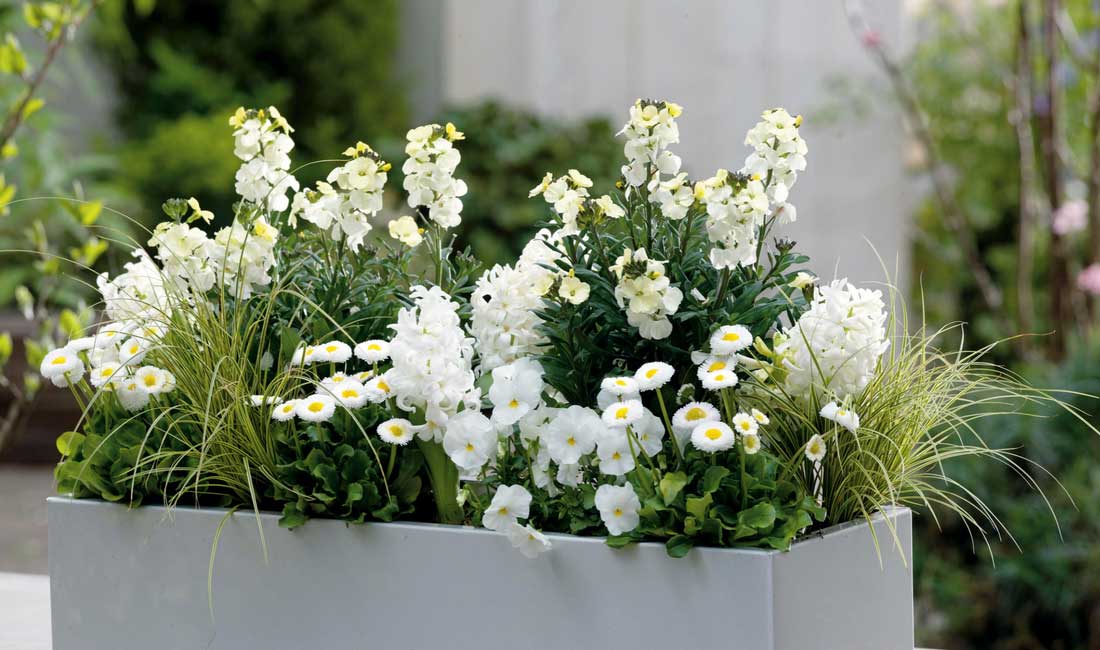

An example of a container arrangement with Wallflowers, Hyacinths, Pansies, Daisies (photo Friedrich Strauss – Biosphoto)
As they enjoy full sun and tolerate drought well, you can also plant them in a dry garden or Mediterranean garden. Pair them with aromatic plants and creeping varieties. They work beautifully with euphorbias (particularly Euphorbia characias), lavender, cotton lavender, Jerusalem sage, rockroses and yarrow… We recommend choosing plants with grey or silver foliage and a cushion-like habit.
Similarly, wallflowers will also thrive in a rockery. They pair wonderfully with saxifrages, sedges, phlox, Erigeron karvinskianus… You can even place your wallflowers directly between the stones of a dry-stone wall, adding charm to the structure. They can be planted alongside other plants that thrive in minimal substrate: stonecrops, wall bellflowers, houseleeks, Cymbalaria muralis… Take advantage of the abundant flowering of aubrietas too!
Since its flowering is early, the common wallflower, Erysimum cheiri, pairs well with spring bulbs such as tulips, daffodils or hyacinths. Add other delicate blooms, such as forget-me-nots, for a vibrant spring display!
With the many varieties available, you can easily create beautiful colour combinations. For example, it’s simple to design a warm-toned scene by pairing Erysimum cheiri with tulips, daffodils, heucheras with orange foliage, bronze or golden-leaved sedges… You can also mix different wallflower varieties.
→ Discover more ideas for pairing wallflowers in the garden or in pots in our advice guide!
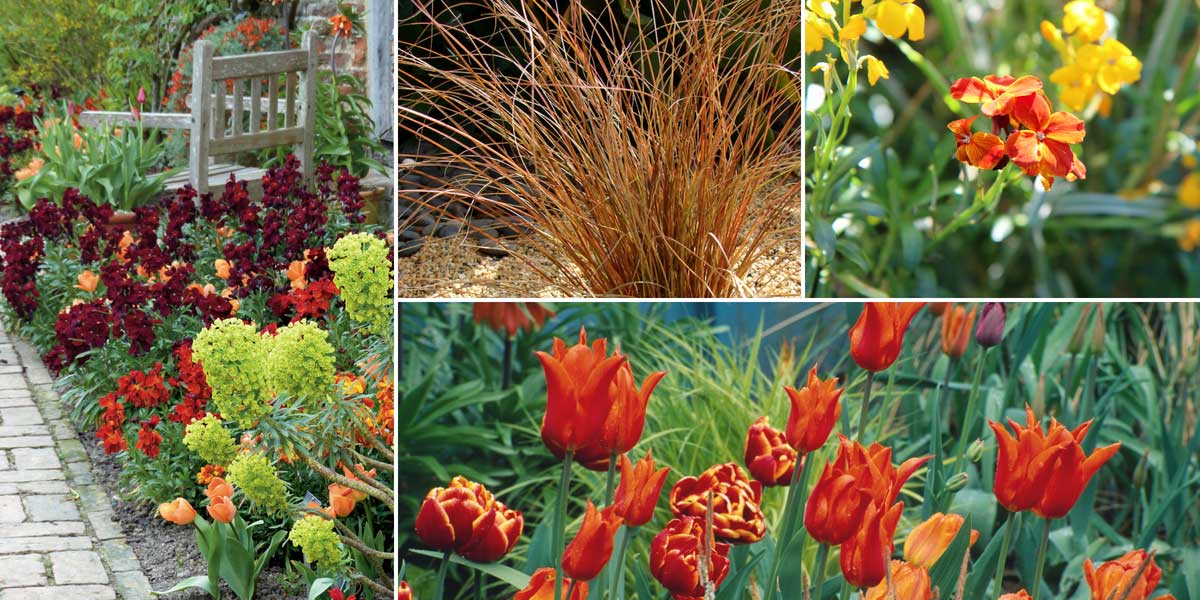

An idea for a warm-toned arrangement. Euphorbia characias ‘Wulfenii’, Erysimum ‘Bedder Scarlet’, Erysimum ‘Bedder Vulcan Brune’ and tulips / Carex comans / Erysimum cheiri / Tulips ‘Ballerina’, ‘Allegretto’ and ‘General de Wet’ (photo Clive Nichols – The Nichols Garden – MAP)
Useful resources
- Discover our range of wallflowers!
- Our wallflower seeds!
- An excellent article about the Wallflower, Erysimum cheiri
- Discover our tips for growing wallflowers in pots
Frequently asked questions
-
The leaves of my wallflower seem nibbled!
The culprits are slugs and snails. To keep them at bay, you can spread ash, sand or sawdust around your young plants. You can also make a slug trap or use anti-slug pellets, such as Ferramol.
-
The leaves of my wallflower have small rust-coloured spots! What should I do?
It is affected by rust disease, caused by a fungus. This disease is not very dangerous, but it is unsightly and weakens the young plant. It is encouraged by humidity and a confined environment. Remove the affected leaves, limit watering, and prune nearby plants if necessary to allow air to circulate. You can treat with a horsetail decoction or a sulphur-based solution.
-
The leaves are riddled with small round holes!
These are flea beetles, small insects (coleoptera), that perforate the leaves of wallflowers and other plants from the same family (Brassicaceae). You can treat them with nettle manure, a tansy infusion or a pyrethrum-based insecticidal spray.
- Subscribe!
- Contents
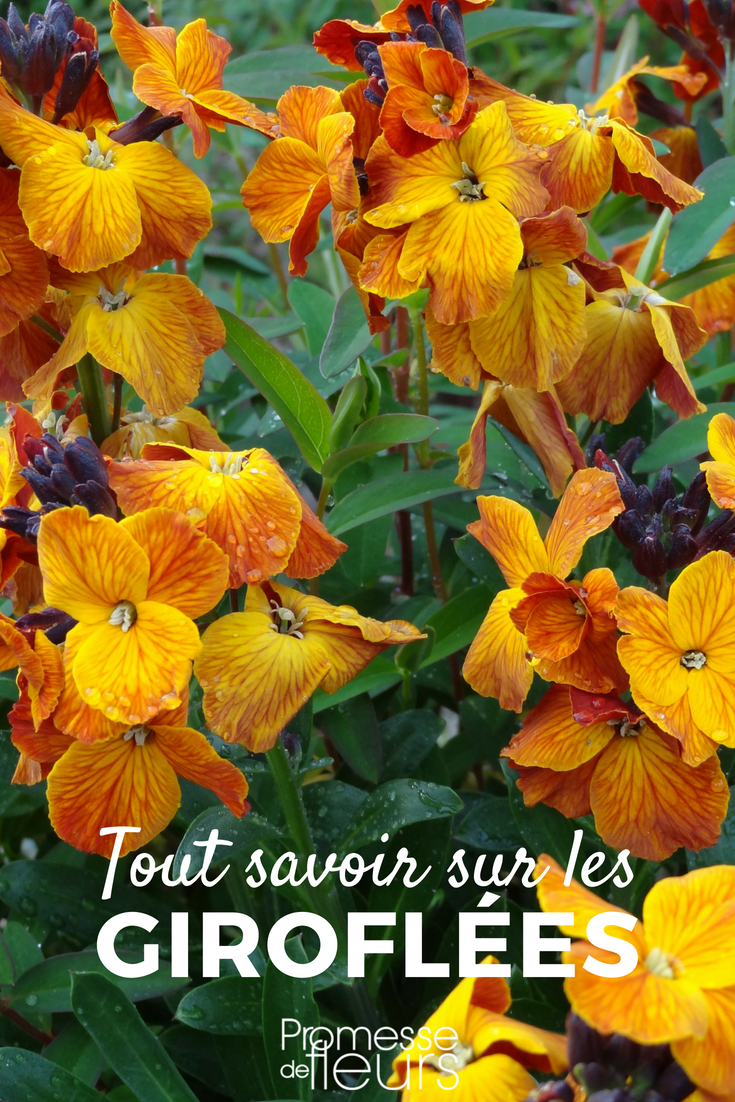


































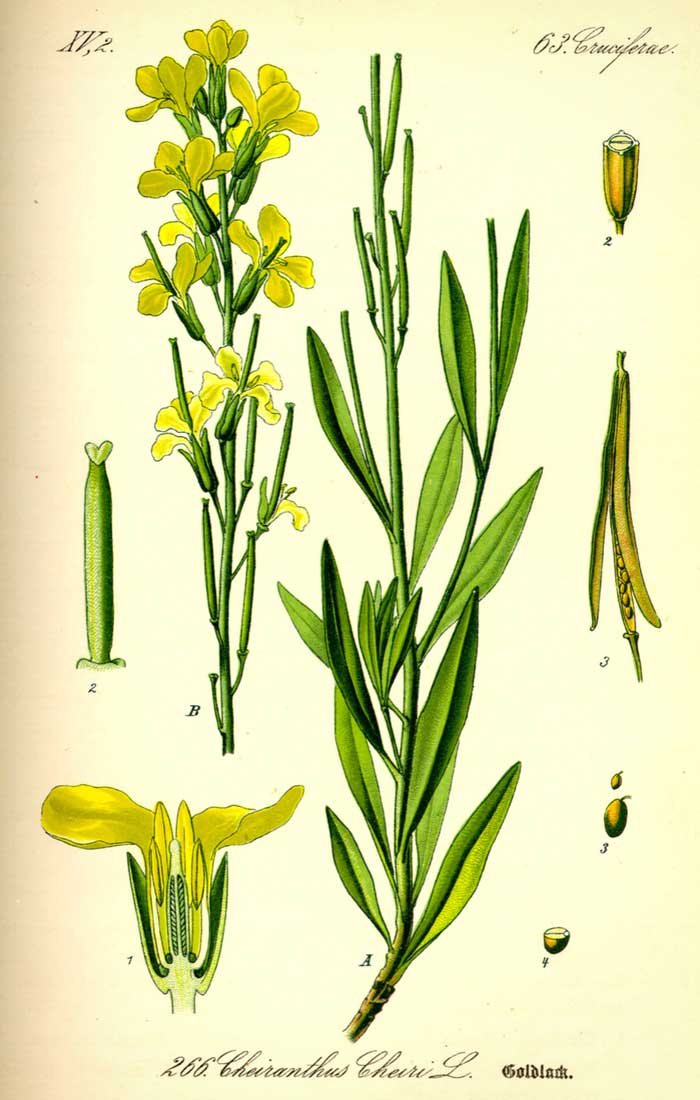
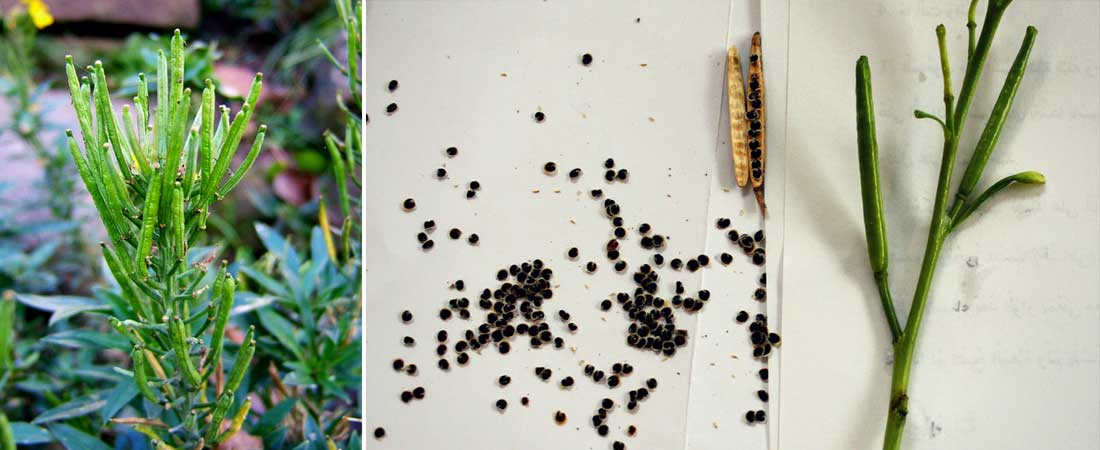




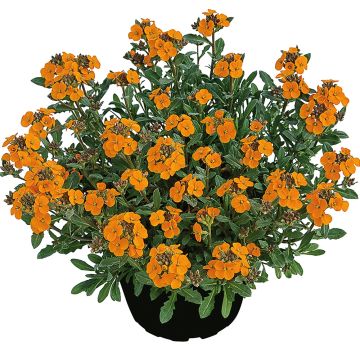
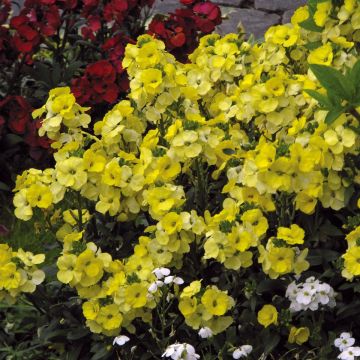
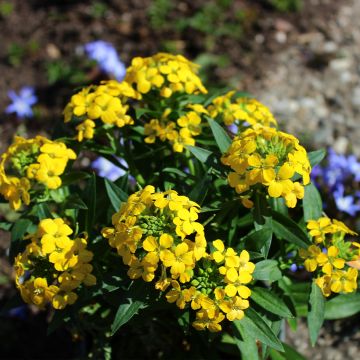
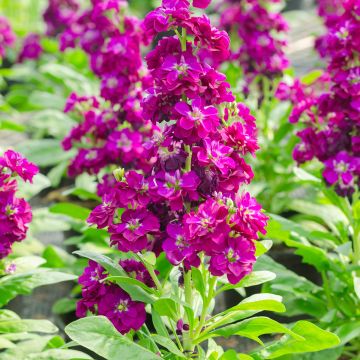

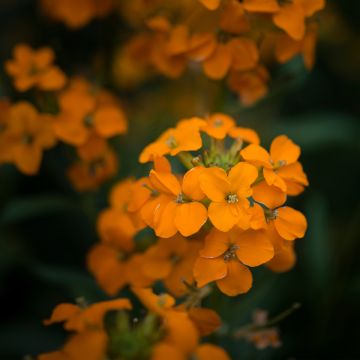
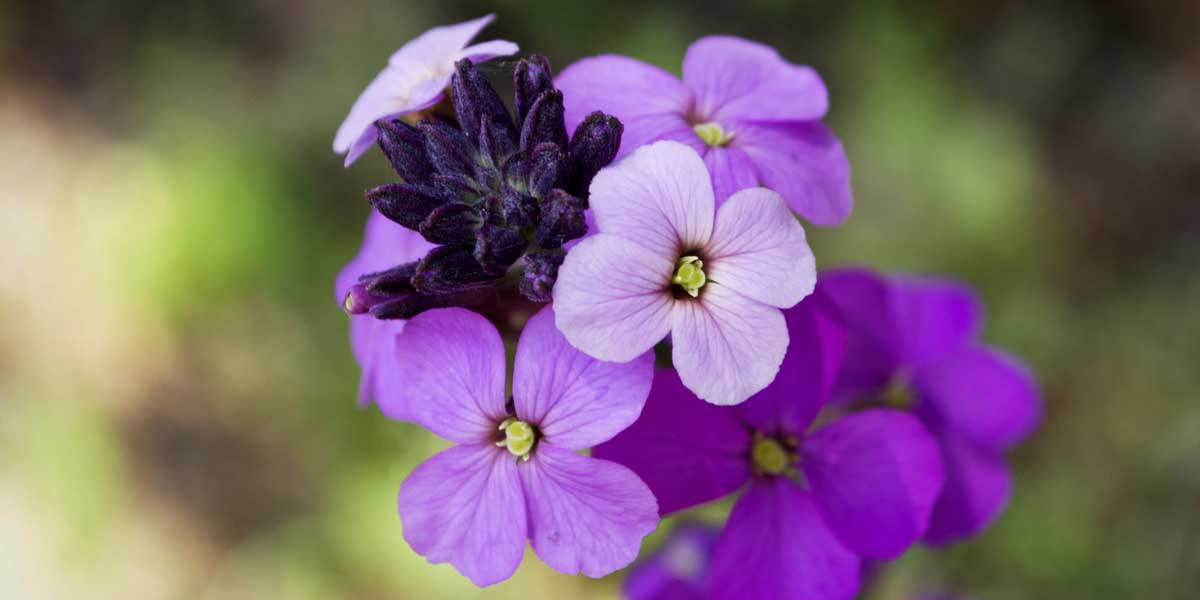
Comments